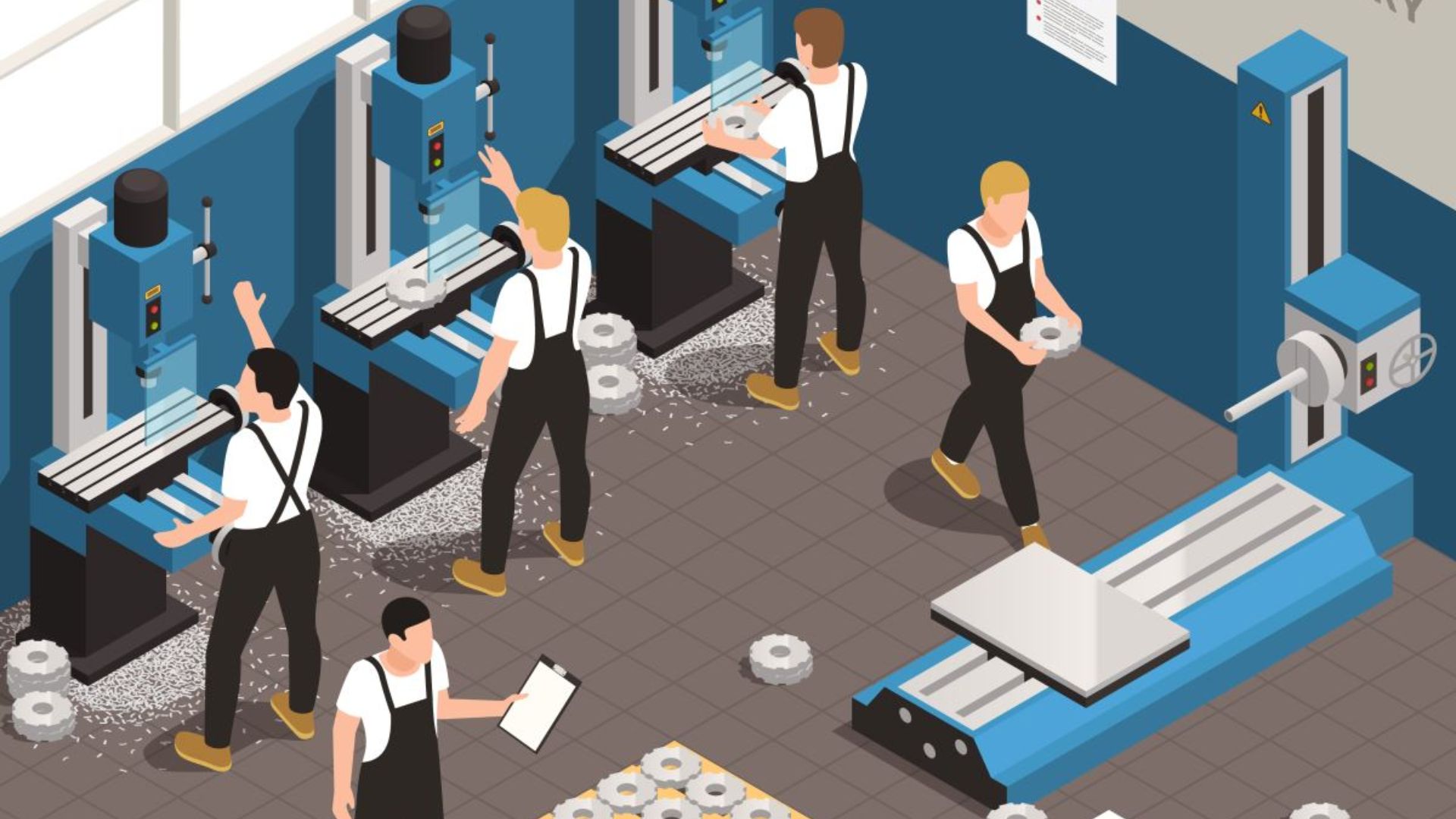Production organization is an important link in the business operation chain, directly determining efficiency, productivity and operating costs. Understanding What is production organization?, as well as how to build a suitable model will help businesses be proactive in resource management, minimize waste and especially optimize cash flow for purchasing raw materials.
In a constantly changing market context, tight control of input costs through modern technological solutions is the key to optimizing production organization processes in a sustainable manner.

1. What is Production Organization?
What is production organization? At its core, Production organization is the process of planning, arranging, coordinating and controlling all resources to transform input materials into finished products or services., meet the goals of quantity, quality, time and cost. The “cost” factor here is not only the product price but also includes all expenses for purchasing, operating and paying suppliers. This is the foundation to ensure 4 main factors: human resources, machinery, raw materials and production space coordinated smoothly and scientifically.
A well-organized production process is not only about operating the production line but also the basis for optimizing resources, flexibly responding to market needs and creating long-term competitive advantages through effective financial management.
1.1 Meaning and Purpose of Production Organization
Building a reasonable production organization system brings many outstanding benefits, especially in financial control and optimizing operating costs.
- Efficient use of resources: Helps businesses optimize the use of raw materials, machinery and human resources. This process is closely linked to business cost management, ensuring all production expenses are tracked and within budget.
- Increase production and business efficiency: Meeting market demand correctly and sufficiently will contribute to boosting revenue. Stable cash flow thanks to good expense management will create conditions for reinvestment and expansion.
- Environmental protection: Deploy energy-saving production solutions, reduce emissions and properly treat waste, and comply with environmental standards.
- Increase internal control: Is the basis for planning, monitoring and making accurate management decisions. Digitalization and automation cost control process help management have a transparent and timely view of production finances.

1.2 Core Functions: Planning – Executing – Controlling
The production organization process includes three closely coordinated functions, in which the financial control element is always integrated.
- Planning function: Determine production goals, prepare resources and budget expenses for each item, from purchasing raw materials to operating costs of machinery.
- Function: Implement production activities according to plan. This stage requires monitoring actual expenditure against budget, ensuring that there are no unnecessary overspending.
- Test function: Monitor product quality, production efficiency and compare invoices and cost documents to promptly adjust if there are any discrepancies or waste.
2. 5 Steps to Effective Production Planning
One spending plan and efficient production is the guiding principle to help businesses optimize resources. This process includes 5 main steps:
- Estimating and forecasting product demand: This is the fundamental step to determine the quantity of raw materials to purchase, thereby accurately estimating the purchasing budget.
- Inventory control: Tight inventory management helps reduce storage costs and avoid wasted capital. This process is directly related to optimization. Accounts Payable Management for the supplier.
- Resource planning: Clearly identify the resources required and their corresponding costs. The application invoice processing automation Input helps the material procurement process take place quickly and accurately.
- Production process monitoring: Continuously monitor production progress and operating costs to ensure everything is under control.
- Evaluate and adjust the plan: Based on actual cost and performance data, businesses need to regularly update plans to optimize production organization process.

3. 5 Golden Rules When Organizing Production
For production operations to run smoothly, businesses need to adhere to core principles, of which financial management integration is indispensable.
Here are 5 principles of production organization important:
- Combining specialization and general business: Assign work clearly according to capacity, while ensuring that the finance and accounting department coordinates closely with the production department.
- Balance between production stages: Ensure processes are at compatible speeds and volumes to eliminate bottlenecks, avoid wasted materials and labor costs.
- Allocate working time reasonably (rhythmically): Build optimal production schedules to improve efficiency and minimize labor costs.
- Maintain continuous production: Proactively control risks by ensuring smooth payment flow to suppliers, avoiding disruptions in material supply.
- Linking production with management: Set up a real-time monitoring and reporting system. This includes integrating production data with expense report, helping leaders make timely adjustment decisions.
4. 5 Common Mistakes When Planning Production Organization
There are 5 common mistakes when planning production organization, many of which stem from poor financial management.
- Mistake #1: Lack of risk management plan: Not budgeting for unexpected situations such as machine breakdowns or sudden increases in raw material prices.
- Mistake #2: Ignoring device management: Unscheduled repair costs are often much higher than regular maintenance costs, negatively impacting the budget.
- Mistake #3: Incorrect demand forecast: Buying too much raw material causes inventory and capital loss; buying too little disrupts production. Both cause financial loss.
- Mistake #4: Lack of coordination between departments: Lack of communication between purchasing, manufacturing and accounting departments often leads to delays in invoice payments, affecting reputation with suppliers.
- Mistake #5: Not applying management technology: Manual cost management using paper and excel is prone to errors, lacks real-time data, making optimization difficult. budget management manufacture.
5. Popular Forms of Production Organization
Depending on the scale and type of product, the business will choose production organization model suitable for optimizing productivity and controlling costs.
| Form | Characteristic | Field of Application |
|---|---|---|
| Production line | Mass production, homogeneous. The stages are arranged continuously. | Consumer goods, electronics, automobile assembly. |
| Group production | Organize into small groups responsible for each section, diverse products. | Manufacture of components and products with many variations. |
| Project based production | Complex products, long implementation time, have separate team. | Construction, shipbuilding, software production. |
| Made to order | Made to order, meeting personalization requirements. | Custom furniture, high-end apparel, printing. |
| Handcrafted | The product is artistic, traditional, small scale. | Handicrafts, specialty foods. |
6. Application of Technology Systems in Production Organization
To production organization Effectively, the application of technology systems to manage operations and finance is an inevitable trend.
6.1 Enterprise Resource Planning (ERP) System
ERP comprehensive management system including linking production data with financial and accounting data.

6.2. Manufacturing Execution System (MES)
MES is a real-time production monitoring system that provides accurate data on performance and material consumption, serving as a basis for cost calculation and cost control.
6.3. Automated financial solutions support efficient production organization
To address financial bottlenecks in manufacturing, spend automation solutions like Bizzi play an indirect but crucial supporting role. They ensure a stable and transparent cash flow for manufacturing.
These solutions help businesses:
- Fully automated payment process: From receiving raw material purchase invoices, reconciling, approving payments to paying suppliers, ensuring no disruption to the supply chain.
- Control costs and debts: Real-time production budget tracking, automated debt management helps stabilize cash flow for continuous operations.
- Working capital financing support: Providing flexible financial solutions when businesses need to expand production or face market fluctuations.

Combining ERP – MES systems with automated financial solutions is the key to helping businesses modernize. production organization, saving costs and increasing overall performance.
7. Frequently Asked Questions (FAQ)
-
To help you better understand the nature and application of production organization in enterprises, below are frequently asked questions with detailed answers:
What are the elements of production organization?
Production organization includes 4 core elements: People (human resources), Machines (equipment, technology), Raw materials (input materials) and Space (premises, factories). Managing costs related to all 4 of these elements is very important.
What is the main objective of production organization?
The main goal is to produce the right quality product, in the right quantity, at the right time at the lowest possible cost. To achieve this, businesses need to strictly control input expenditure.
What is the difference between assembly line manufacturing and project manufacturing?
Assembly line manufacturing focuses on creating large quantities of uniform products at optimized cost per unit. In contrast, project-based manufacturing is for complex, unique products that require managing individual budgets for each project.
Conclude
Clearly understand What is production organization? It is not only about understanding the operating process, but also about mastering the problem of cost and efficiency. An effective production organization process must be associated with a solid financial management system. Instead of operating manually and separately, businesses can now apply financial and accounting process automation solutions from Bizzi to increase connectivity, transparency and optimize comprehensive resources, creating a solid foundation for sustainable production development.


